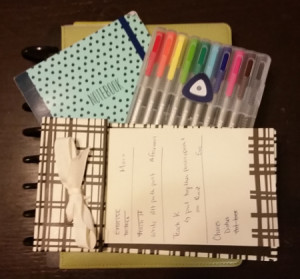As it turns out, after financial security maintaining a work-life balance is what entrepreneurs struggle with as a fear pretty high on the scale. It’s no wonder when there is such pressure to have it all. Work-life balance is everything in this day in age, and you can find a million lists out there giving you ideas on how to achieve in. A quick search on Bing returns 4,510,000 results. Google has 167,000,000 results, several of them in scholarly articles.
Clearly, it’s a huge priority for a lot of people. We all want to have careers/jobs we love, then go home and play just as hard as we worked, perhaps harder. We strive every day to achieve this ideal path for ourselves.
I believe that this balance is a myth.
Last year I worked four jobs during the summer and fall. This year I’m also working 4 jobs while maintaining a house and picking up after two cats and a fiancé. I go out with friends from time to time to go out to eat, catch a movie or play a game of Magic… or three. At home I don’t feel rushed when the cats or fiancé want attention, and in fact I even make time for the occasional game of KoL. The thing is, while you might call this insane, I call it normal. Actually, normal for me was taking a 21 credit hour semester at Purdue and working 5 jobs. That was 5 classes, two of them with lab components making the classes span all week-long. I worked well into the night at any of the labs or on my homework — often both at the same time.
Most people ask me how I pull it off with poise and balance. The secret is…
I don’t.
I feel stress, de-motivation, and burnout just like everyone else. There are three main differences I’ve seen so far: 1.) I’m not afraid to set boundaries and stick to them. 2.) I don’t tell myself how miserable I am while these feelings are going on. Instead, I remind myself that I have the power to choose things. 3.) I have ADHD that I have learnt to harness.
Of all these, unmedicated ADHD is probably the most powerful weapon against destructiveness I have. Not only am I easily distracted from things that would normally get me down, but learning to live with and function very well with it has taught me a lot of tricks. Here are the tricks I’ve learnt over the years, and they are yours for the taking.
-

I use an Arc Junior, simple notebook with unlined pages, coloured markers, and a note pad with the daily tasks.
Make a to-do list and set priorities. This is one of those “obvious” things, but I use it in such a way that pulls my mind back from wandering. I literally take a notebook with me everywhere and write notes in it whenever they pop up. They aren’t in any order, but I’ll put flags on the pages to note something important, or if it’s really important, I’ll transfer it to Evernote. If it’s something like “pay the bills”, I’ll transfer it to a note pad that sits on my desk with my daily task list on it.
- Use technology and tools that work to keep me organised. I’m very much an analogue type of person, so I don’t try to use my phone, fancy apps, or anything like that. Instead, I make sure I use the tools that work for the job I need it to. A day planner to have the bigger picture, a place to jot down notes, and a place to keep the list. I also like to colour code things, so coloured pens are never far behind, either.
- Embrace your energy needs. One of the curses with ADHD is endless loops of distraction or sometimes just staring into space for long periods of time. I found this comes with low energy periods, which for me centre around meal time slumps. So, during this time I schedule “low energy” or “low attentiveness” tasks. These are things like doing the dishes, picking up the house, and reading industry news. Then, when my energy peaks, I can do more energy or attentive tasks, like customer projects.
- Use a timer as needed. Let’s face it, with a hellish schedule, there are times when you have low energy all the time. It’s times like these where you want to slump back to the couch or just mindlessly scroll through the internet. Recognise it, then set a timer for things that you know you’ll get distracted by. For example, my colleague gets distracted in research, where he’ll spend hours reading unrelated Wiki links to his original goal. This would be a perfect time to set the timer for 30 minutes and say, “Within this 30 minutes, I want to have the first sections of the outline done.”
- Quilt time together when you have a lot of things going on. Time quilting is a term I picked up from Chris Brogan, but I’ve been doing for years unknowingly. It’s when you use scraps of time you have, whenever you have it, to get things done. Chris uses blocks on a spreadsheet to keep his thoughts organised, while I keep a to-do list. The concept is still similar, though, in that we build our task list with parts that need to be execute, colour code, and set priorities on each task, and then execute each part as you get the time. Little by little, it will get done. It may not be pretty, but it will be done.
- Embrace the chaos with the right mindset. I found that mindset is 98% of everything I do. If I go into it with a negative “I don’t want to” mindset, I’ll hate it, procrastinate, do a terrible job, you name it. It’s not pretty. But, when I go in with a positive attitude even focusing on the most remote silver lining, the whole project turns around into something amazing. The best part is? It makes the projects go smoother and quicker.
- Embrace structure and systems to make things flow better. Did you know that systems are not restrictive in the least? They give your life a backbone to work off of so you can do what it necessary, when you need to do it. There are many systems available out there to choose from, but that’s really not what you’re looking for. Trust me. As someone who has tried nearly all of them, the best ones are the ones that are cobbled together piecemeal for you and your needs. Someone that needs to focus on their business might choose Systems Rock as a primary methodology, but then use elements of My Tiny Empire to keep their home life sane. The key is to build the systems that work for you.
- Exercise regularly and eat healthy for optimal attitude. I don’t know about you, but stretching makes my body feel better, running reduces stress, and MMA training makes me feel like a bad ass that can take on the world. But, all of that means nothing if I don’t eat healthy and fuel myself with the right foods. Yeah, sometimes this means going out for a real burrito (not the kind from Chipolte, but from a real Mexican restaurant, dripping with gooey cheese) or a plate of fish and chips. Sometimes it means indulging in a piece of cake. All of that is in moderation, while the bulk of the fuel comes from nutritiously dense and healthy food — like veggies and lean protein. Eating right and fuelling the body like it wants to be fuelled is what will keep you from hunting sustenance instead of working.
- Make play dates and down time part of your routine. When you are a workaholic like I am, taking time out is considerably difficult. There are times when I have to force myself to stop working and enjoy things around me. But, as you’ll read all over the place, it helps reset the mind and allows you to open up more. After learning this lesson the hard way, I started getting smart and scheduling them into the day. Every hour I take a few moments to stand up, stretch, go to a window and absorb some sunlight, whatever needs to be done to refresh for the next 55 minutes or so. (I don’t really time it, it’s just that’s when I need to get more tea.) Schedule in play dates, such as lunch out as well, and do so regularly if you want to. I don’t because I’m a happy introvert, but others need that contact and they should embrace it so they can work more efficiently for their own needs.
- Know Thyself. The key to all of this is knowing what makes you tick and what you need for optimal efficiency. This doesn’t mean longer hours, but smarter hours. To do this, sit down with yourself and meditate daily — I do this with my morning cup of coffee as I take stock of how I’m
 feeling so I can adjust accordingly. Take on the world days mean more gets accomplished, while feeling blah means I shuffle things around if I can to make some more downtime. It is also helpful to sit down once a week and do an after action review of the week. I like to use Kathryn Brown’s Productivity Planner for this since it asks you about the week that just went by, followed by the next week coming up — which is exactly what you need to do. I add on another layer to plug everything into my quarterly view, which goes into my year goals — but none of this gets very far without the baby steps of knowing thyself day in and day out so you can accomplish exactly what you set out to do.
feeling so I can adjust accordingly. Take on the world days mean more gets accomplished, while feeling blah means I shuffle things around if I can to make some more downtime. It is also helpful to sit down once a week and do an after action review of the week. I like to use Kathryn Brown’s Productivity Planner for this since it asks you about the week that just went by, followed by the next week coming up — which is exactly what you need to do. I add on another layer to plug everything into my quarterly view, which goes into my year goals — but none of this gets very far without the baby steps of knowing thyself day in and day out so you can accomplish exactly what you set out to do.
Now that you know what keys I use for balancing ADHD with a whirlwind of a life, you can take advantage of it. Start by taking a step back and really looking at things and what you need. I’d recommend starting with analysing your energy levels so you can arrange your days to accomplish things when you can work efficiently on the tasks.
Oh, and parents, your kids don’t need to be medicated. They just need to learn to discipline themselves and work within a similar frame. 🙂
Thoughts? Arguments? Debates? Let’s go in the comments!







